Corporate and Financial Accounting Report: Consolidation and Analysis
VerifiedAdded on 2023/01/06
|13
|3110
|34
Report
AI Summary
This report provides a comprehensive analysis of corporate and financial accounting principles. It begins with journal entries and ledger postings related to share applications. The report then delves into the reasons and methods for corporate share capital reduction, differentiating between share buybacks and capital reduction. It explores different types of debt instruments and discusses ways companies expand by obtaining new assets, including the preparation of journal entries for acquisitions. The report also examines intra-group transactions, including journal entries for elimination, profit realization, and the rules for dividend eliminations. Finally, it includes a worksheet, consolidation adjustments, and elimination entries using the NET method.

Corporate and
Financial Accounting
Financial Accounting
Paraphrase This Document
Need a fresh take? Get an instant paraphrase of this document with our AI Paraphraser
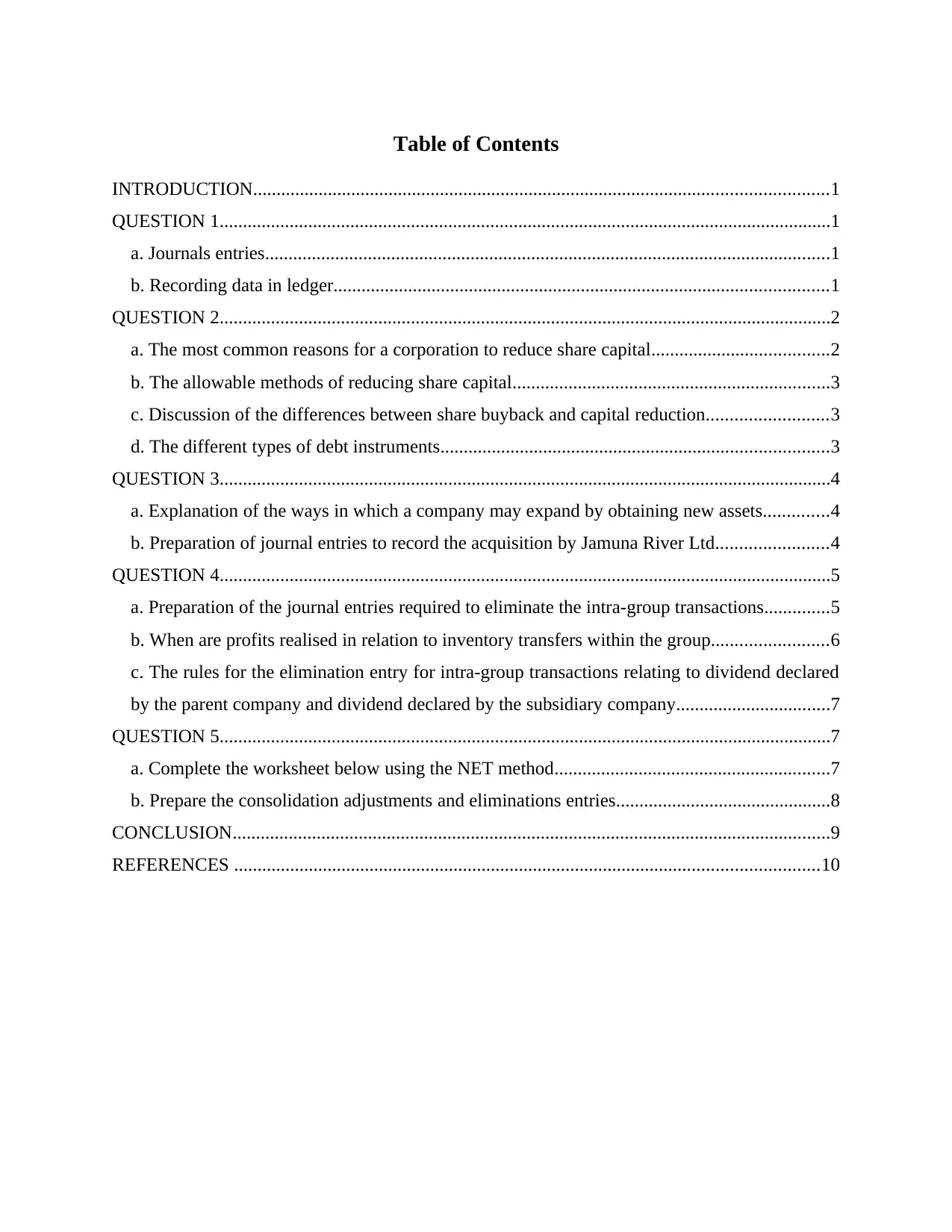
Table of Contents
INTRODUCTION...........................................................................................................................1
QUESTION 1...................................................................................................................................1
a. Journals entries.........................................................................................................................1
b. Recording data in ledger..........................................................................................................1
QUESTION 2...................................................................................................................................2
a. The most common reasons for a corporation to reduce share capital......................................2
b. The allowable methods of reducing share capital....................................................................3
c. Discussion of the differences between share buyback and capital reduction..........................3
d. The different types of debt instruments...................................................................................3
QUESTION 3...................................................................................................................................4
a. Explanation of the ways in which a company may expand by obtaining new assets..............4
b. Preparation of journal entries to record the acquisition by Jamuna River Ltd........................4
QUESTION 4...................................................................................................................................5
a. Preparation of the journal entries required to eliminate the intra-group transactions..............5
b. When are profits realised in relation to inventory transfers within the group.........................6
c. The rules for the elimination entry for intra-group transactions relating to dividend declared
by the parent company and dividend declared by the subsidiary company.................................7
QUESTION 5...................................................................................................................................7
a. Complete the worksheet below using the NET method...........................................................7
b. Prepare the consolidation adjustments and eliminations entries..............................................8
CONCLUSION................................................................................................................................9
REFERENCES .............................................................................................................................10
INTRODUCTION...........................................................................................................................1
QUESTION 1...................................................................................................................................1
a. Journals entries.........................................................................................................................1
b. Recording data in ledger..........................................................................................................1
QUESTION 2...................................................................................................................................2
a. The most common reasons for a corporation to reduce share capital......................................2
b. The allowable methods of reducing share capital....................................................................3
c. Discussion of the differences between share buyback and capital reduction..........................3
d. The different types of debt instruments...................................................................................3
QUESTION 3...................................................................................................................................4
a. Explanation of the ways in which a company may expand by obtaining new assets..............4
b. Preparation of journal entries to record the acquisition by Jamuna River Ltd........................4
QUESTION 4...................................................................................................................................5
a. Preparation of the journal entries required to eliminate the intra-group transactions..............5
b. When are profits realised in relation to inventory transfers within the group.........................6
c. The rules for the elimination entry for intra-group transactions relating to dividend declared
by the parent company and dividend declared by the subsidiary company.................................7
QUESTION 5...................................................................................................................................7
a. Complete the worksheet below using the NET method...........................................................7
b. Prepare the consolidation adjustments and eliminations entries..............................................8
CONCLUSION................................................................................................................................9
REFERENCES .............................................................................................................................10
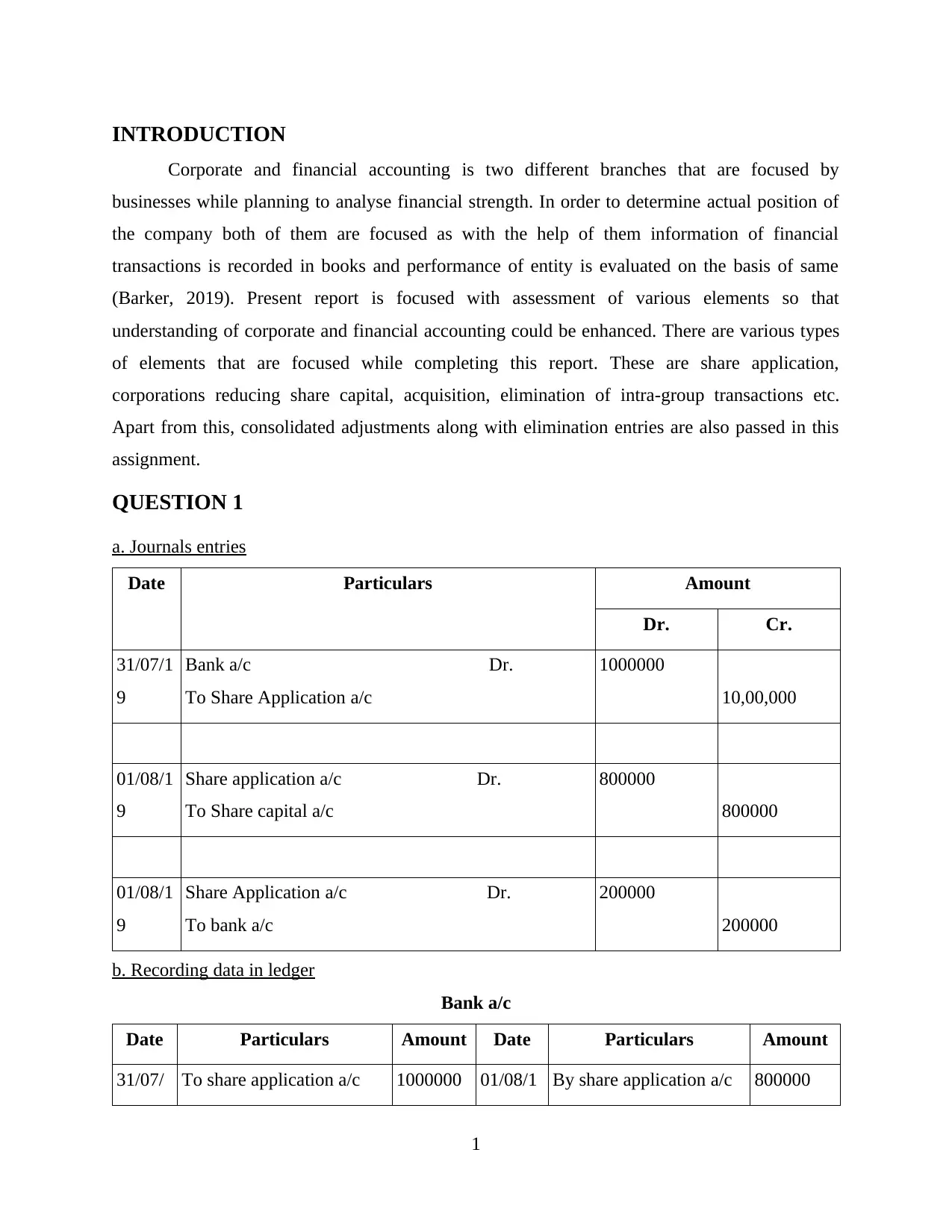
INTRODUCTION
Corporate and financial accounting is two different branches that are focused by
businesses while planning to analyse financial strength. In order to determine actual position of
the company both of them are focused as with the help of them information of financial
transactions is recorded in books and performance of entity is evaluated on the basis of same
(Barker, 2019). Present report is focused with assessment of various elements so that
understanding of corporate and financial accounting could be enhanced. There are various types
of elements that are focused while completing this report. These are share application,
corporations reducing share capital, acquisition, elimination of intra-group transactions etc.
Apart from this, consolidated adjustments along with elimination entries are also passed in this
assignment.
QUESTION 1
a. Journals entries
Date Particulars Amount
Dr. Cr.
31/07/1
9
Bank a/c Dr.
To Share Application a/c
1000000
10,00,000
01/08/1
9
Share application a/c Dr.
To Share capital a/c
800000
800000
01/08/1
9
Share Application a/c Dr.
To bank a/c
200000
200000
b. Recording data in ledger
Bank a/c
Date Particulars Amount Date Particulars Amount
31/07/ To share application a/c 1000000 01/08/1 By share application a/c 800000
1
Corporate and financial accounting is two different branches that are focused by
businesses while planning to analyse financial strength. In order to determine actual position of
the company both of them are focused as with the help of them information of financial
transactions is recorded in books and performance of entity is evaluated on the basis of same
(Barker, 2019). Present report is focused with assessment of various elements so that
understanding of corporate and financial accounting could be enhanced. There are various types
of elements that are focused while completing this report. These are share application,
corporations reducing share capital, acquisition, elimination of intra-group transactions etc.
Apart from this, consolidated adjustments along with elimination entries are also passed in this
assignment.
QUESTION 1
a. Journals entries
Date Particulars Amount
Dr. Cr.
31/07/1
9
Bank a/c Dr.
To Share Application a/c
1000000
10,00,000
01/08/1
9
Share application a/c Dr.
To Share capital a/c
800000
800000
01/08/1
9
Share Application a/c Dr.
To bank a/c
200000
200000
b. Recording data in ledger
Bank a/c
Date Particulars Amount Date Particulars Amount
31/07/ To share application a/c 1000000 01/08/1 By share application a/c 800000
1
⊘ This is a preview!⊘
Do you want full access?
Subscribe today to unlock all pages.

Trusted by 1+ million students worldwide
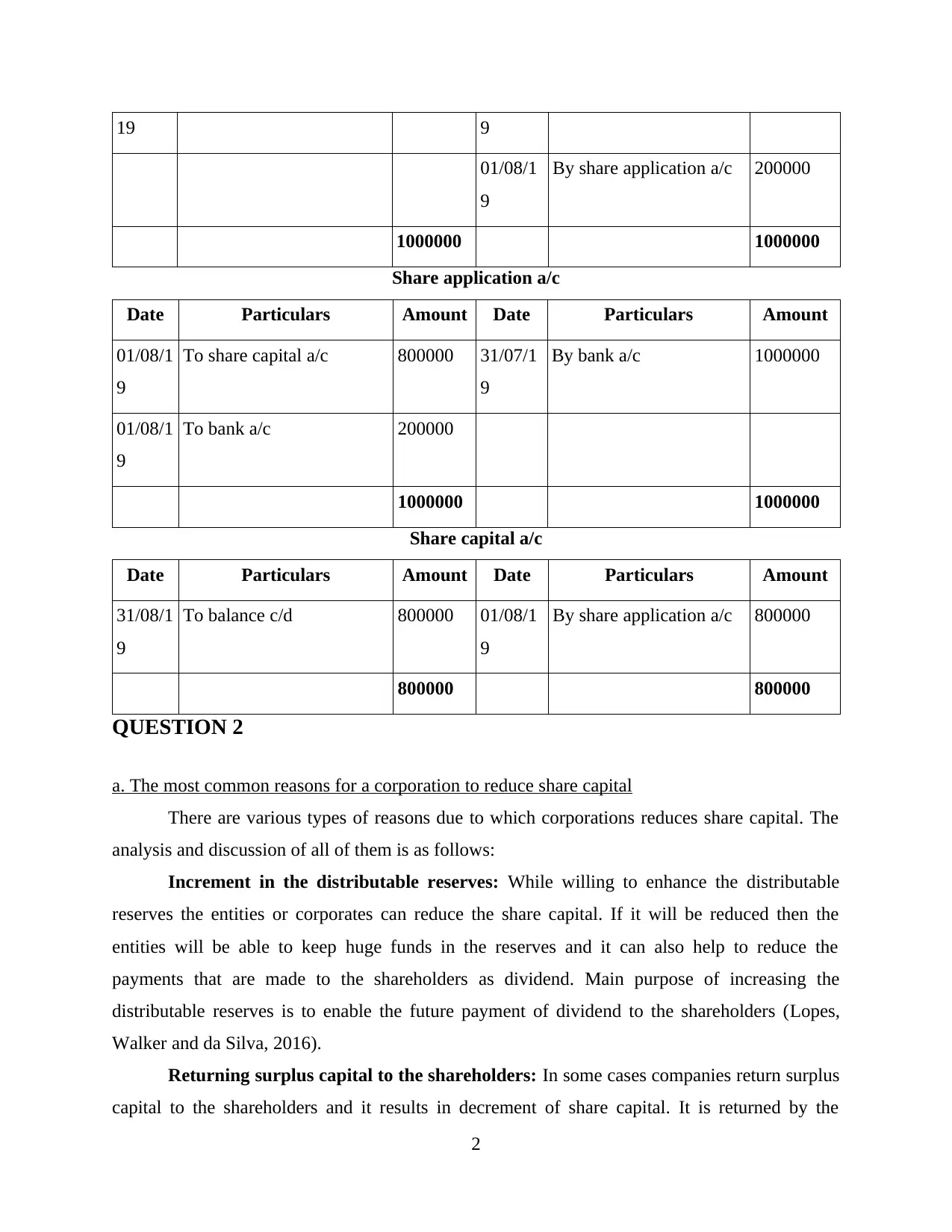
19 9
01/08/1
9
By share application a/c 200000
1000000 1000000
Share application a/c
Date Particulars Amount Date Particulars Amount
01/08/1
9
To share capital a/c 800000 31/07/1
9
By bank a/c 1000000
01/08/1
9
To bank a/c 200000
1000000 1000000
Share capital a/c
Date Particulars Amount Date Particulars Amount
31/08/1
9
To balance c/d 800000 01/08/1
9
By share application a/c 800000
800000 800000
QUESTION 2
a. The most common reasons for a corporation to reduce share capital
There are various types of reasons due to which corporations reduces share capital. The
analysis and discussion of all of them is as follows:
Increment in the distributable reserves: While willing to enhance the distributable
reserves the entities or corporates can reduce the share capital. If it will be reduced then the
entities will be able to keep huge funds in the reserves and it can also help to reduce the
payments that are made to the shareholders as dividend. Main purpose of increasing the
distributable reserves is to enable the future payment of dividend to the shareholders (Lopes,
Walker and da Silva, 2016).
Returning surplus capital to the shareholders: In some cases companies return surplus
capital to the shareholders and it results in decrement of share capital. It is returned by the
2
01/08/1
9
By share application a/c 200000
1000000 1000000
Share application a/c
Date Particulars Amount Date Particulars Amount
01/08/1
9
To share capital a/c 800000 31/07/1
9
By bank a/c 1000000
01/08/1
9
To bank a/c 200000
1000000 1000000
Share capital a/c
Date Particulars Amount Date Particulars Amount
31/08/1
9
To balance c/d 800000 01/08/1
9
By share application a/c 800000
800000 800000
QUESTION 2
a. The most common reasons for a corporation to reduce share capital
There are various types of reasons due to which corporations reduces share capital. The
analysis and discussion of all of them is as follows:
Increment in the distributable reserves: While willing to enhance the distributable
reserves the entities or corporates can reduce the share capital. If it will be reduced then the
entities will be able to keep huge funds in the reserves and it can also help to reduce the
payments that are made to the shareholders as dividend. Main purpose of increasing the
distributable reserves is to enable the future payment of dividend to the shareholders (Lopes,
Walker and da Silva, 2016).
Returning surplus capital to the shareholders: In some cases companies return surplus
capital to the shareholders and it results in decrement of share capital. It is returned by the
2
Paraphrase This Document
Need a fresh take? Get an instant paraphrase of this document with our AI Paraphraser
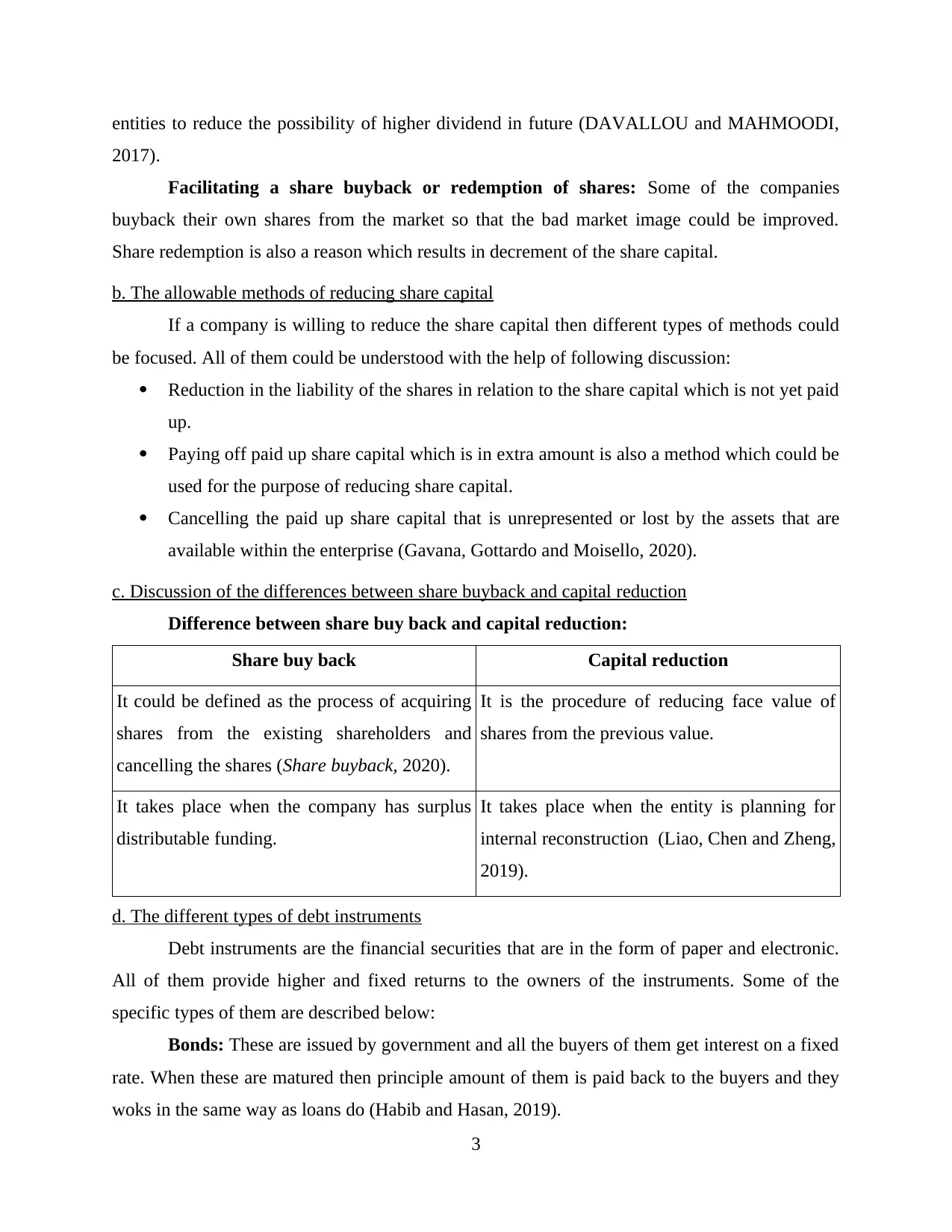
entities to reduce the possibility of higher dividend in future (DAVALLOU and MAHMOODI,
2017).
Facilitating a share buyback or redemption of shares: Some of the companies
buyback their own shares from the market so that the bad market image could be improved.
Share redemption is also a reason which results in decrement of the share capital.
b. The allowable methods of reducing share capital
If a company is willing to reduce the share capital then different types of methods could
be focused. All of them could be understood with the help of following discussion:
Reduction in the liability of the shares in relation to the share capital which is not yet paid
up.
Paying off paid up share capital which is in extra amount is also a method which could be
used for the purpose of reducing share capital.
Cancelling the paid up share capital that is unrepresented or lost by the assets that are
available within the enterprise (Gavana, Gottardo and Moisello, 2020).
c. Discussion of the differences between share buyback and capital reduction
Difference between share buy back and capital reduction:
Share buy back Capital reduction
It could be defined as the process of acquiring
shares from the existing shareholders and
cancelling the shares (Share buyback, 2020).
It is the procedure of reducing face value of
shares from the previous value.
It takes place when the company has surplus
distributable funding.
It takes place when the entity is planning for
internal reconstruction (Liao, Chen and Zheng,
2019).
d. The different types of debt instruments
Debt instruments are the financial securities that are in the form of paper and electronic.
All of them provide higher and fixed returns to the owners of the instruments. Some of the
specific types of them are described below:
Bonds: These are issued by government and all the buyers of them get interest on a fixed
rate. When these are matured then principle amount of them is paid back to the buyers and they
woks in the same way as loans do (Habib and Hasan, 2019).
3
2017).
Facilitating a share buyback or redemption of shares: Some of the companies
buyback their own shares from the market so that the bad market image could be improved.
Share redemption is also a reason which results in decrement of the share capital.
b. The allowable methods of reducing share capital
If a company is willing to reduce the share capital then different types of methods could
be focused. All of them could be understood with the help of following discussion:
Reduction in the liability of the shares in relation to the share capital which is not yet paid
up.
Paying off paid up share capital which is in extra amount is also a method which could be
used for the purpose of reducing share capital.
Cancelling the paid up share capital that is unrepresented or lost by the assets that are
available within the enterprise (Gavana, Gottardo and Moisello, 2020).
c. Discussion of the differences between share buyback and capital reduction
Difference between share buy back and capital reduction:
Share buy back Capital reduction
It could be defined as the process of acquiring
shares from the existing shareholders and
cancelling the shares (Share buyback, 2020).
It is the procedure of reducing face value of
shares from the previous value.
It takes place when the company has surplus
distributable funding.
It takes place when the entity is planning for
internal reconstruction (Liao, Chen and Zheng,
2019).
d. The different types of debt instruments
Debt instruments are the financial securities that are in the form of paper and electronic.
All of them provide higher and fixed returns to the owners of the instruments. Some of the
specific types of them are described below:
Bonds: These are issued by government and all the buyers of them get interest on a fixed
rate. When these are matured then principle amount of them is paid back to the buyers and they
woks in the same way as loans do (Habib and Hasan, 2019).
3
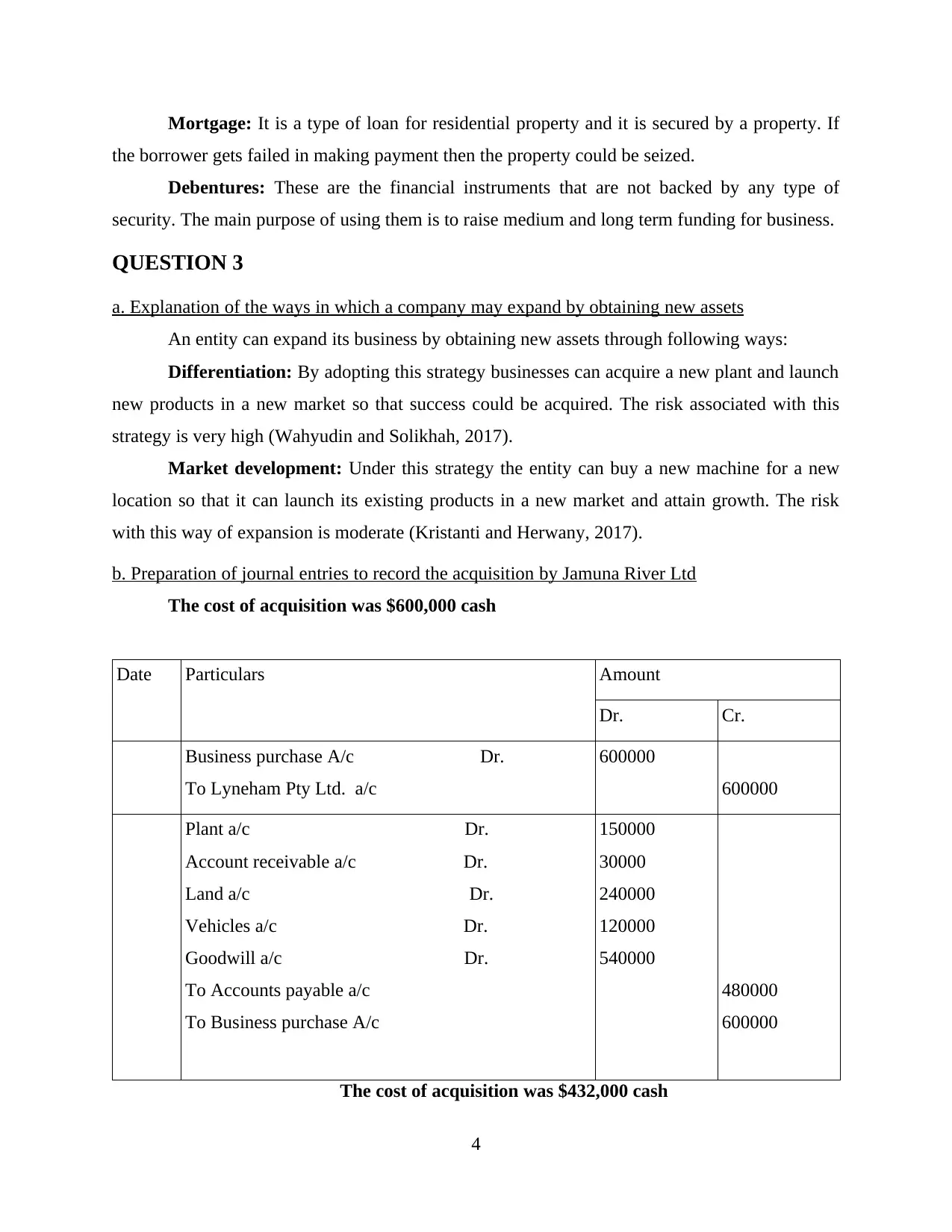
Mortgage: It is a type of loan for residential property and it is secured by a property. If
the borrower gets failed in making payment then the property could be seized.
Debentures: These are the financial instruments that are not backed by any type of
security. The main purpose of using them is to raise medium and long term funding for business.
QUESTION 3
a. Explanation of the ways in which a company may expand by obtaining new assets
An entity can expand its business by obtaining new assets through following ways:
Differentiation: By adopting this strategy businesses can acquire a new plant and launch
new products in a new market so that success could be acquired. The risk associated with this
strategy is very high (Wahyudin and Solikhah, 2017).
Market development: Under this strategy the entity can buy a new machine for a new
location so that it can launch its existing products in a new market and attain growth. The risk
with this way of expansion is moderate (Kristanti and Herwany, 2017).
b. Preparation of journal entries to record the acquisition by Jamuna River Ltd
The cost of acquisition was $600,000 cash
Date Particulars Amount
Dr. Cr.
Business purchase A/c Dr.
To Lyneham Pty Ltd. a/c
600000
600000
Plant a/c Dr.
Account receivable a/c Dr.
Land a/c Dr.
Vehicles a/c Dr.
Goodwill a/c Dr.
To Accounts payable a/c
To Business purchase A/c
150000
30000
240000
120000
540000
480000
600000
The cost of acquisition was $432,000 cash
4
the borrower gets failed in making payment then the property could be seized.
Debentures: These are the financial instruments that are not backed by any type of
security. The main purpose of using them is to raise medium and long term funding for business.
QUESTION 3
a. Explanation of the ways in which a company may expand by obtaining new assets
An entity can expand its business by obtaining new assets through following ways:
Differentiation: By adopting this strategy businesses can acquire a new plant and launch
new products in a new market so that success could be acquired. The risk associated with this
strategy is very high (Wahyudin and Solikhah, 2017).
Market development: Under this strategy the entity can buy a new machine for a new
location so that it can launch its existing products in a new market and attain growth. The risk
with this way of expansion is moderate (Kristanti and Herwany, 2017).
b. Preparation of journal entries to record the acquisition by Jamuna River Ltd
The cost of acquisition was $600,000 cash
Date Particulars Amount
Dr. Cr.
Business purchase A/c Dr.
To Lyneham Pty Ltd. a/c
600000
600000
Plant a/c Dr.
Account receivable a/c Dr.
Land a/c Dr.
Vehicles a/c Dr.
Goodwill a/c Dr.
To Accounts payable a/c
To Business purchase A/c
150000
30000
240000
120000
540000
480000
600000
The cost of acquisition was $432,000 cash
4
⊘ This is a preview!⊘
Do you want full access?
Subscribe today to unlock all pages.

Trusted by 1+ million students worldwide
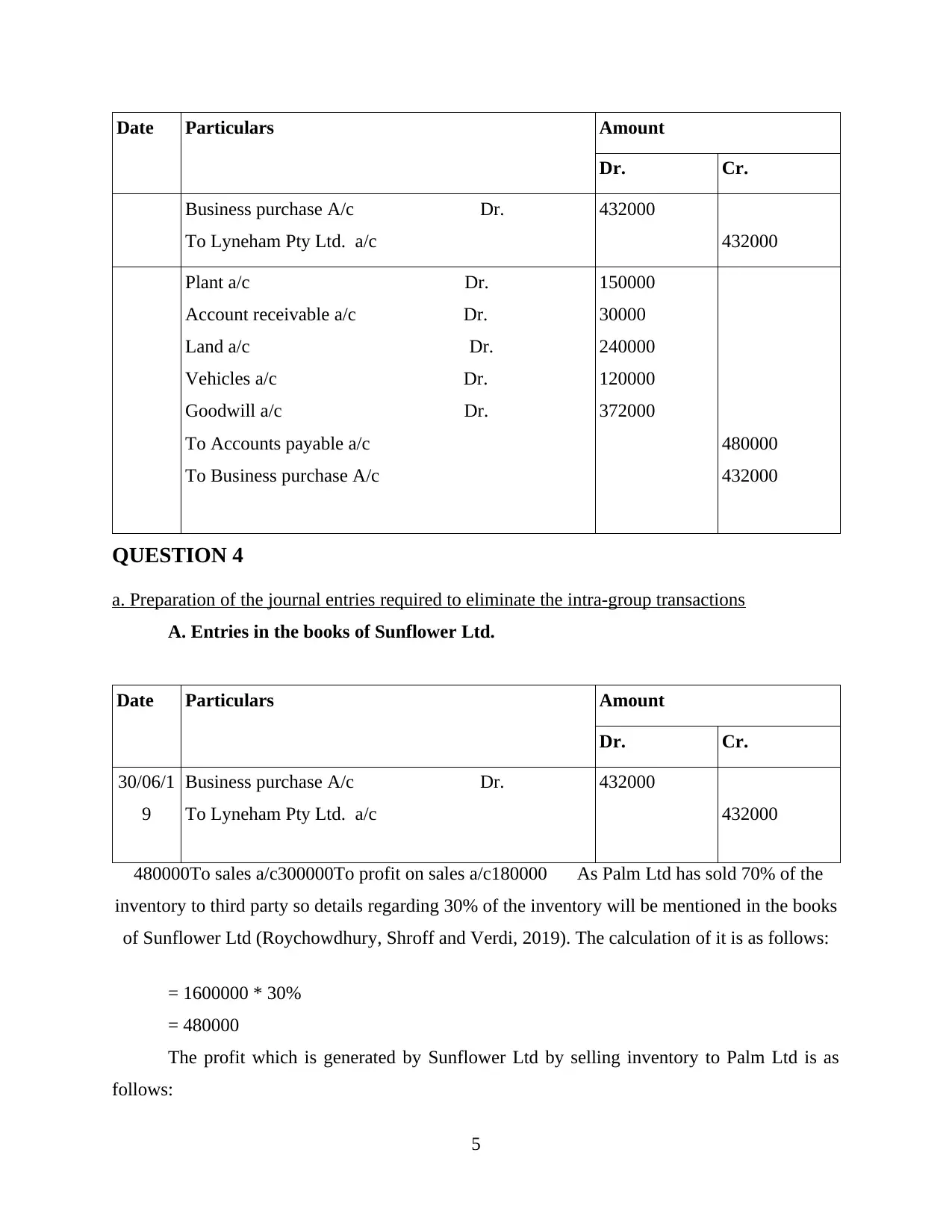
Date Particulars Amount
Dr. Cr.
Business purchase A/c Dr.
To Lyneham Pty Ltd. a/c
432000
432000
Plant a/c Dr.
Account receivable a/c Dr.
Land a/c Dr.
Vehicles a/c Dr.
Goodwill a/c Dr.
To Accounts payable a/c
To Business purchase A/c
150000
30000
240000
120000
372000
480000
432000
QUESTION 4
a. Preparation of the journal entries required to eliminate the intra-group transactions
A. Entries in the books of Sunflower Ltd.
Date Particulars Amount
Dr. Cr.
30/06/1
9
Business purchase A/c Dr.
To Lyneham Pty Ltd. a/c
432000
432000
480000To sales a/c300000To profit on sales a/c180000 As Palm Ltd has sold 70% of the
inventory to third party so details regarding 30% of the inventory will be mentioned in the books
of Sunflower Ltd (Roychowdhury, Shroff and Verdi, 2019). The calculation of it is as follows:
= 1600000 * 30%
= 480000
The profit which is generated by Sunflower Ltd by selling inventory to Palm Ltd is as
follows:
5
Dr. Cr.
Business purchase A/c Dr.
To Lyneham Pty Ltd. a/c
432000
432000
Plant a/c Dr.
Account receivable a/c Dr.
Land a/c Dr.
Vehicles a/c Dr.
Goodwill a/c Dr.
To Accounts payable a/c
To Business purchase A/c
150000
30000
240000
120000
372000
480000
432000
QUESTION 4
a. Preparation of the journal entries required to eliminate the intra-group transactions
A. Entries in the books of Sunflower Ltd.
Date Particulars Amount
Dr. Cr.
30/06/1
9
Business purchase A/c Dr.
To Lyneham Pty Ltd. a/c
432000
432000
480000To sales a/c300000To profit on sales a/c180000 As Palm Ltd has sold 70% of the
inventory to third party so details regarding 30% of the inventory will be mentioned in the books
of Sunflower Ltd (Roychowdhury, Shroff and Verdi, 2019). The calculation of it is as follows:
= 1600000 * 30%
= 480000
The profit which is generated by Sunflower Ltd by selling inventory to Palm Ltd is as
follows:
5
Paraphrase This Document
Need a fresh take? Get an instant paraphrase of this document with our AI Paraphraser

= 1600000 – 1000000
= 600000
Percentage of profit = 600000 / 1600000 * 100
= 37.5%
So the profit for 30% of the inventory will be as follows
= 480000 * 37.5%
= 180000
B. Declaration of dividend:
Date Particulars Amount
Dr. Cr.
30/06/1
9
Net profit a/c Dr.
To Dividend payable a/c
1300000
1300000
30/06/1
9
Dividend payable a/c Dr.
To bank a/c
1300000
1300000
C. Payment of fee for administrative services:
Date Particulars Amount
Dr. Cr.
30/06/1
9
Bank / cash A/c Dr.
To Palm Ltd (fee for administrative services)
40000
40000
D. Unpaid interest:
Date Particulars Amount
Dr. Cr.
30/06/1
9
Accrued Interest A/c Dr.
To interest a/c
400000
400000
E. Purchase of land from Palm Ltd.:
6
= 600000
Percentage of profit = 600000 / 1600000 * 100
= 37.5%
So the profit for 30% of the inventory will be as follows
= 480000 * 37.5%
= 180000
B. Declaration of dividend:
Date Particulars Amount
Dr. Cr.
30/06/1
9
Net profit a/c Dr.
To Dividend payable a/c
1300000
1300000
30/06/1
9
Dividend payable a/c Dr.
To bank a/c
1300000
1300000
C. Payment of fee for administrative services:
Date Particulars Amount
Dr. Cr.
30/06/1
9
Bank / cash A/c Dr.
To Palm Ltd (fee for administrative services)
40000
40000
D. Unpaid interest:
Date Particulars Amount
Dr. Cr.
30/06/1
9
Accrued Interest A/c Dr.
To interest a/c
400000
400000
E. Purchase of land from Palm Ltd.:
6

Date Particulars Amount
Dr. Cr.
30/06/1
9
Land A/c Dr.
To Palm Ltd a/c
560000
560000
b. When are profits realised in relation to inventory transfers within the group
If the inventory will be transferred by one entity to another entity in the same group then
profits will be realised when the buying entity will sale them to third party. If the inventory will
be used to carry out all the operations in future then profits will not be realised. In case of
Sunflower and Palm Ltd. the profit for selling or buying the inventory will be realised when
Palm Ltd will sale the bought goods to third party. As 70% of the goods are sold to third party so
the profit will be realised for 30% of the inventory (Sorensen and Miller, 2017).
c. The rules for the elimination entry for intra-group transactions relating to dividend declared by
the parent company and dividend declared by the subsidiary company
When a company acquires another company then different types of intra group
transactions take place. In order to get rid of them different elimination entries are passed. Such
types of entries allow the representation of the account balances together because the parent and
subsidiary company are single enterprise. When all the elimination entries are passed then parent
organisation analyse the total remaining balances for all the accounts and then this information is
used to prepare consolidated financial statements (Koo, Ramalingegowda and Yu, 2017).
The rules regarding elimination entry fro dividend declared by parent and subsidiary
company is that both the companies are required to pass entry of declared dividend but the parent
entity will disclose the information of both. On the other hand, subsidiary firm will disclose the
details of own dividend only as it will help to eliminate the intra-group transactions (Unerman,
Bebbington and O’dwyer, 2018).
7
Dr. Cr.
30/06/1
9
Land A/c Dr.
To Palm Ltd a/c
560000
560000
b. When are profits realised in relation to inventory transfers within the group
If the inventory will be transferred by one entity to another entity in the same group then
profits will be realised when the buying entity will sale them to third party. If the inventory will
be used to carry out all the operations in future then profits will not be realised. In case of
Sunflower and Palm Ltd. the profit for selling or buying the inventory will be realised when
Palm Ltd will sale the bought goods to third party. As 70% of the goods are sold to third party so
the profit will be realised for 30% of the inventory (Sorensen and Miller, 2017).
c. The rules for the elimination entry for intra-group transactions relating to dividend declared by
the parent company and dividend declared by the subsidiary company
When a company acquires another company then different types of intra group
transactions take place. In order to get rid of them different elimination entries are passed. Such
types of entries allow the representation of the account balances together because the parent and
subsidiary company are single enterprise. When all the elimination entries are passed then parent
organisation analyse the total remaining balances for all the accounts and then this information is
used to prepare consolidated financial statements (Koo, Ramalingegowda and Yu, 2017).
The rules regarding elimination entry fro dividend declared by parent and subsidiary
company is that both the companies are required to pass entry of declared dividend but the parent
entity will disclose the information of both. On the other hand, subsidiary firm will disclose the
details of own dividend only as it will help to eliminate the intra-group transactions (Unerman,
Bebbington and O’dwyer, 2018).
7
⊘ This is a preview!⊘
Do you want full access?
Subscribe today to unlock all pages.

Trusted by 1+ million students worldwide
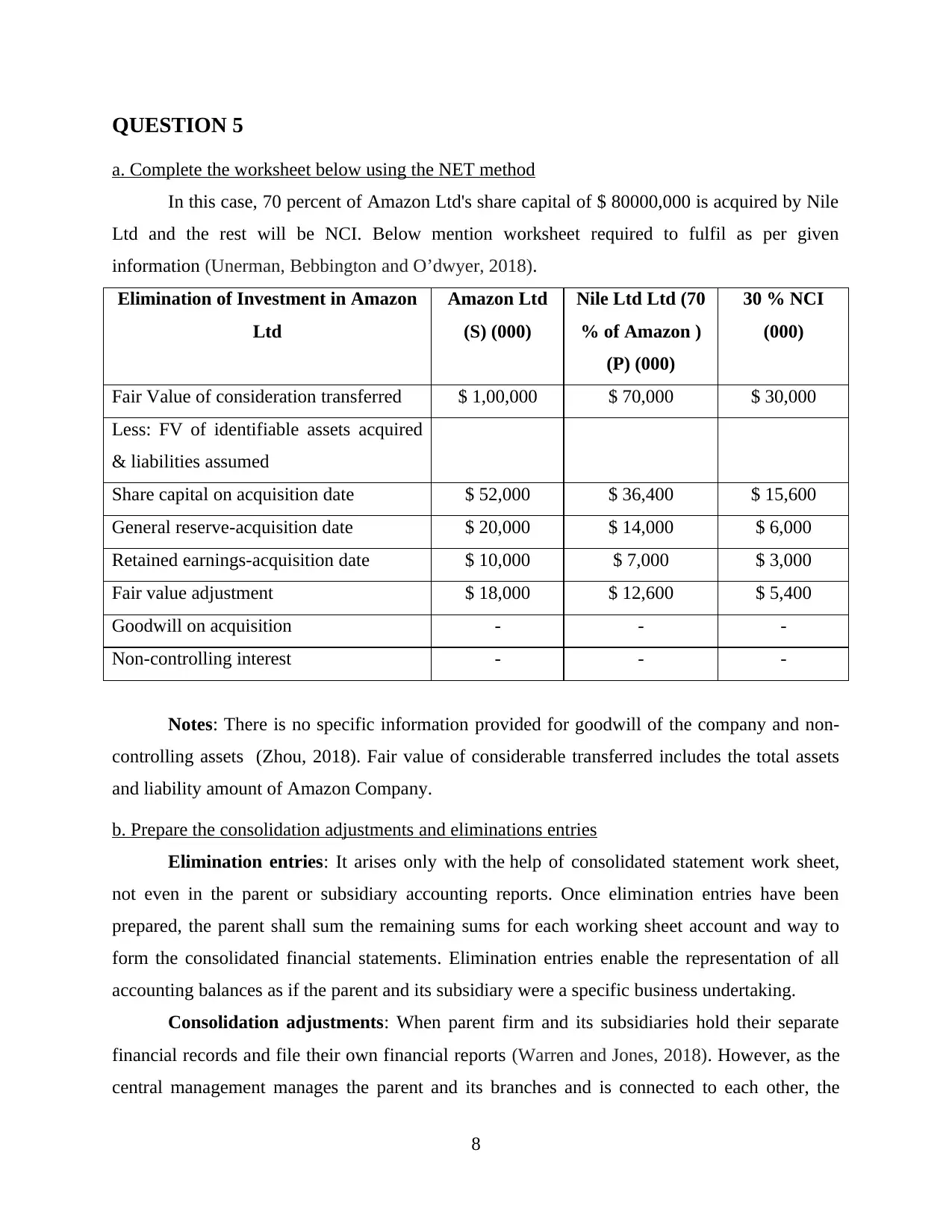
QUESTION 5
a. Complete the worksheet below using the NET method
In this case, 70 percent of Amazon Ltd's share capital of $ 80000,000 is acquired by Nile
Ltd and the rest will be NCI. Below mention worksheet required to fulfil as per given
information (Unerman, Bebbington and O’dwyer, 2018).
Elimination of Investment in Amazon
Ltd
Amazon Ltd
(S) (000)
Nile Ltd Ltd (70
% of Amazon )
(P) (000)
30 % NCI
(000)
Fair Value of consideration transferred $ 1,00,000 $ 70,000 $ 30,000
Less: FV of identifiable assets acquired
& liabilities assumed
Share capital on acquisition date $ 52,000 $ 36,400 $ 15,600
General reserve-acquisition date $ 20,000 $ 14,000 $ 6,000
Retained earnings-acquisition date $ 10,000 $ 7,000 $ 3,000
Fair value adjustment $ 18,000 $ 12,600 $ 5,400
Goodwill on acquisition - - -
Non-controlling interest - - -
Notes: There is no specific information provided for goodwill of the company and non-
controlling assets (Zhou, 2018). Fair value of considerable transferred includes the total assets
and liability amount of Amazon Company.
b. Prepare the consolidation adjustments and eliminations entries
Elimination entries: It arises only with the help of consolidated statement work sheet,
not even in the parent or subsidiary accounting reports. Once elimination entries have been
prepared, the parent shall sum the remaining sums for each working sheet account and way to
form the consolidated financial statements. Elimination entries enable the representation of all
accounting balances as if the parent and its subsidiary were a specific business undertaking.
Consolidation adjustments: When parent firm and its subsidiaries hold their separate
financial records and file their own financial reports (Warren and Jones, 2018). However, as the
central management manages the parent and its branches and is connected to each other, the
8
a. Complete the worksheet below using the NET method
In this case, 70 percent of Amazon Ltd's share capital of $ 80000,000 is acquired by Nile
Ltd and the rest will be NCI. Below mention worksheet required to fulfil as per given
information (Unerman, Bebbington and O’dwyer, 2018).
Elimination of Investment in Amazon
Ltd
Amazon Ltd
(S) (000)
Nile Ltd Ltd (70
% of Amazon )
(P) (000)
30 % NCI
(000)
Fair Value of consideration transferred $ 1,00,000 $ 70,000 $ 30,000
Less: FV of identifiable assets acquired
& liabilities assumed
Share capital on acquisition date $ 52,000 $ 36,400 $ 15,600
General reserve-acquisition date $ 20,000 $ 14,000 $ 6,000
Retained earnings-acquisition date $ 10,000 $ 7,000 $ 3,000
Fair value adjustment $ 18,000 $ 12,600 $ 5,400
Goodwill on acquisition - - -
Non-controlling interest - - -
Notes: There is no specific information provided for goodwill of the company and non-
controlling assets (Zhou, 2018). Fair value of considerable transferred includes the total assets
and liability amount of Amazon Company.
b. Prepare the consolidation adjustments and eliminations entries
Elimination entries: It arises only with the help of consolidated statement work sheet,
not even in the parent or subsidiary accounting reports. Once elimination entries have been
prepared, the parent shall sum the remaining sums for each working sheet account and way to
form the consolidated financial statements. Elimination entries enable the representation of all
accounting balances as if the parent and its subsidiary were a specific business undertaking.
Consolidation adjustments: When parent firm and its subsidiaries hold their separate
financial records and file their own financial reports (Warren and Jones, 2018). However, as the
central management manages the parent and its branches and is connected to each other, the
8
Paraphrase This Document
Need a fresh take? Get an instant paraphrase of this document with our AI Paraphraser
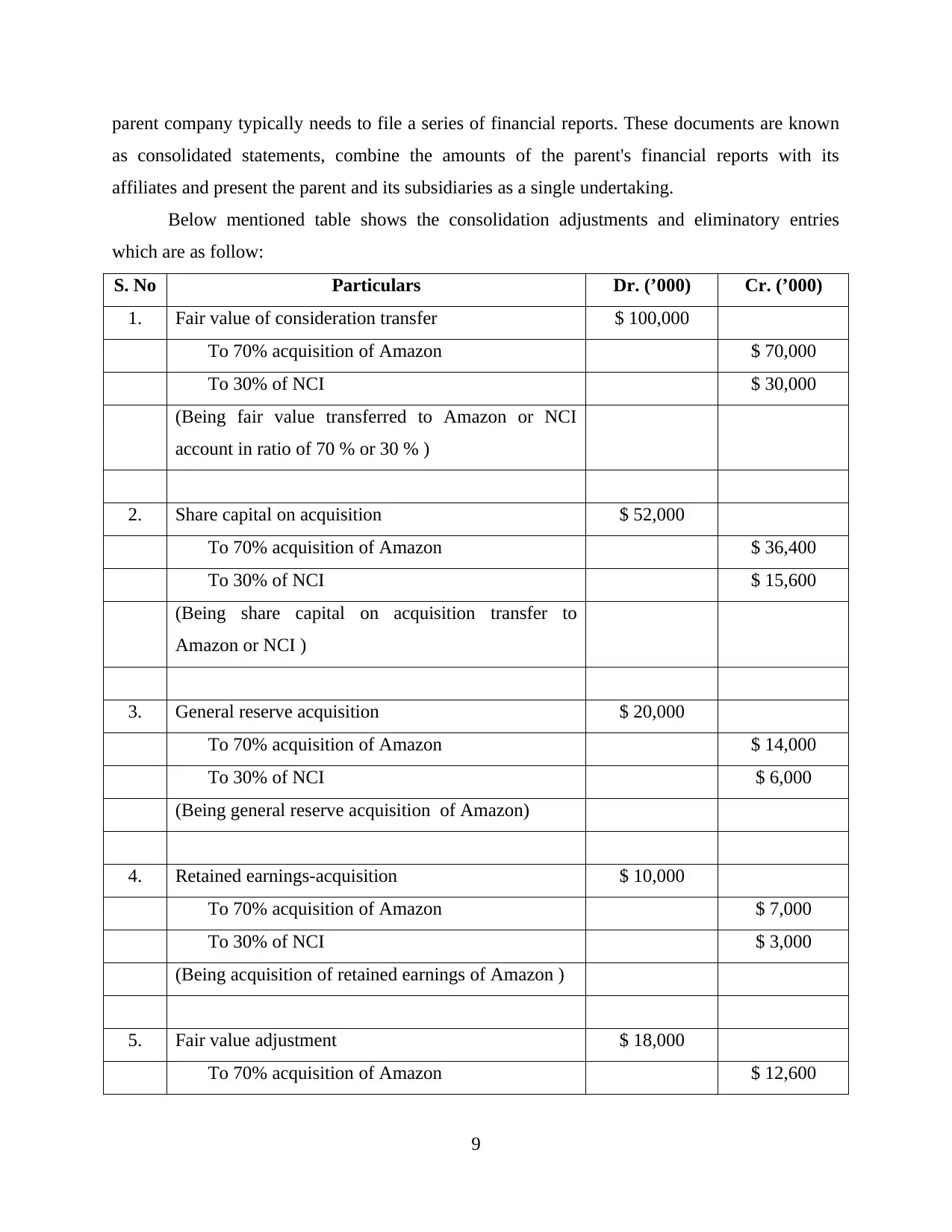
parent company typically needs to file a series of financial reports. These documents are known
as consolidated statements, combine the amounts of the parent's financial reports with its
affiliates and present the parent and its subsidiaries as a single undertaking.
Below mentioned table shows the consolidation adjustments and eliminatory entries
which are as follow:
S. No Particulars Dr. (’000) Cr. (’000)
1. Fair value of consideration transfer $ 100,000
To 70% acquisition of Amazon $ 70,000
To 30% of NCI $ 30,000
(Being fair value transferred to Amazon or NCI
account in ratio of 70 % or 30 % )
2. Share capital on acquisition $ 52,000
To 70% acquisition of Amazon $ 36,400
To 30% of NCI $ 15,600
(Being share capital on acquisition transfer to
Amazon or NCI )
3. General reserve acquisition $ 20,000
To 70% acquisition of Amazon $ 14,000
To 30% of NCI $ 6,000
(Being general reserve acquisition of Amazon)
4. Retained earnings-acquisition $ 10,000
To 70% acquisition of Amazon $ 7,000
To 30% of NCI $ 3,000
(Being acquisition of retained earnings of Amazon )
5. Fair value adjustment $ 18,000
To 70% acquisition of Amazon $ 12,600
9
as consolidated statements, combine the amounts of the parent's financial reports with its
affiliates and present the parent and its subsidiaries as a single undertaking.
Below mentioned table shows the consolidation adjustments and eliminatory entries
which are as follow:
S. No Particulars Dr. (’000) Cr. (’000)
1. Fair value of consideration transfer $ 100,000
To 70% acquisition of Amazon $ 70,000
To 30% of NCI $ 30,000
(Being fair value transferred to Amazon or NCI
account in ratio of 70 % or 30 % )
2. Share capital on acquisition $ 52,000
To 70% acquisition of Amazon $ 36,400
To 30% of NCI $ 15,600
(Being share capital on acquisition transfer to
Amazon or NCI )
3. General reserve acquisition $ 20,000
To 70% acquisition of Amazon $ 14,000
To 30% of NCI $ 6,000
(Being general reserve acquisition of Amazon)
4. Retained earnings-acquisition $ 10,000
To 70% acquisition of Amazon $ 7,000
To 30% of NCI $ 3,000
(Being acquisition of retained earnings of Amazon )
5. Fair value adjustment $ 18,000
To 70% acquisition of Amazon $ 12,600
9

To 30% of NCI $ 5,400
(Adjustment of fair value)
Total $ 200,000 $ 200,000
CONCLUSION
From the above project report, it has been concluded that corporate and financial
accounting are required to be focused by businesses so that growth could be acquired by them.
There are various types of elements that are taken in to consideration while using them. These
are acquisition, share application, intra group transactions, debt instruments etc.
10
(Adjustment of fair value)
Total $ 200,000 $ 200,000
CONCLUSION
From the above project report, it has been concluded that corporate and financial
accounting are required to be focused by businesses so that growth could be acquired by them.
There are various types of elements that are taken in to consideration while using them. These
are acquisition, share application, intra group transactions, debt instruments etc.
10
⊘ This is a preview!⊘
Do you want full access?
Subscribe today to unlock all pages.

Trusted by 1+ million students worldwide
1 out of 13
Related Documents
Your All-in-One AI-Powered Toolkit for Academic Success.
+13062052269
info@desklib.com
Available 24*7 on WhatsApp / Email
![[object Object]](/_next/static/media/star-bottom.7253800d.svg)
Unlock your academic potential
Copyright © 2020–2025 A2Z Services. All Rights Reserved. Developed and managed by ZUCOL.




